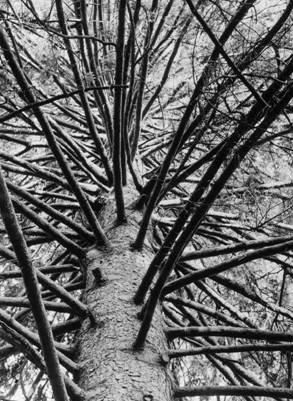Patzsch and Ernst Junger
dal 2/11/2011 al 25/2/2012
Segnalato da
2/11/2011
Patzsch and Ernst Junger
Pinakothek der Moderne, Munich
The exhibition 'Of Trees and Rocks-Albert Renger-Patzsch and Ernst Junger' presents around 30 original photographs by Albert Renger-Patzsch, as well as the historic photobooks themselves and a selection from his correspondence with the author, chosen by Ann and Jurgen Wilde.

In a letter to Ernst Jünger, Albert Renger-Patzsch describes his work for the publications “Bäume” (“Trees”, 1962) and “Gestein” (“Rocks”, 1966) as “the sum of [his] existence”. They were to be the last two photobooks that the most famous protagonist of New Objectivity photography published before his death in 1966. Both series of works had been initiated and funded by the industrialist Ernst Boehringer, for whom Albert Renger-Patzsch had already completed several projects since 1949. The books were published after lengthy preparations and in an elaborate production process, in a small run, printed by the private press of the C.H. Boehringer Ingelheim pharmaceutical company and were aimed at an exclusive audience.
Albert Renger-Patzsch’s exploration of nature as a motif is not merely a phenomenon of his late work. Even in the early stages of his photographic career, in his work on the plant books for the Auriga publishing house in the early 1920s, the photographer used the theme of nature to try out his technical skills, and in doing so ultimately developed the kind of photographic repertoire for which he continues to be known today: truncated images, extreme sharpness and a particular focus on surface qualities. The work series, “Bäume” and “Gestein” are an unbroken reflection of these characteristics, even though the dynamism of his early photographs gives way to a more static visual style in the late work. The viewer’s gaze is now steered away from the single, visually dense image to a series of images taken of the same circle of motifs. As Albert Renger-Patzsch once emphasised to Boehringer, “circling the subject” was the highest goal in the book projects they worked on together and was something that
had to be achieved not just optically, but also from a scientific and literary perspective. In keeping with this idea, an essay by the famous author Ernst Jünger was incorporated in each photobook, alongside texts from a dendrologist and geologist respectively. Jünger’s texts juxtaposed Renger-Patzsch’s photographic documentation with a mystical exploration of the subject. The lively correspondence between Renger-Patzsch and Jünger, maintained from 1943 to 1966, testifies to the fact that the photographer was not merely aware of the difference between the photographic and literary exploration of the theme, but positively welcomed it. These letters make clear where exactly Albert Renger-Patzsch saw his work, positioned between science and literature, and how he wanted his last two publications to be understood.
Albert Renger-Patzsch (1897 Würzburg – 1966 Wamel) The son of a passionate amateur photographer, Albert Renger-Patzsch learnt the technical aspects of handling a camera while still a child. After abandoning his studies in chemistry in Dresden, he took up the post as head of the picture archive at Folkwang, a publishing house in North Rhine-Westphalia (which later became known
as Auriga), where, besides cataloguing museum objects, he was also responsible for illustrating picture books. From 1925 until his death in 1966, Albert Renger-Patzsch was active as a freelance photographer. His many publications included “Die Welt ist
schön” (“The World is Beautiful”, 1928) his most well-known and best received work. It is still regarded the incunabulum of New Objectivity photography and covers the full photographic spectrum of Albert Renger-Patzsch’s work: starting in advertising
and industrial photography and stretching up to architectural and landscape photography.
Ernst Jünger (1895 Heidelberg – 1998 Riedlingen)
Ernst Jünger, known as an author, philosopher and entomologist, started publishing poems while still in school and had a keen interest in the world of insects. Shortly after the outbreak of the First World War, Jünger volunteered for duty and went on
to receive the highest military medals over the following years. Jünger published his diary sketches, “Storm of Steel” (1920), subtitled “From the Diary of a German Storm-Troop Officer on the Western Front”, while still serving as an officer in the Reichswehr. In the book he tries to come to grips with his experiences in the war. Until his death at the age of 102, Ernst Jünger composed numerous essays and novels, including “Der Kampf als inneres Erlebnis” (1922), “Das abenteuerliche Herz” (“The
Adventurous Heart”, 1929), “Der Arbeiter” (1932), “Auf den Marmorklippen” (“On the Marble Cliffs”, 1939), “Der Waldgang” (1952), “Der Weltstaat” (1960), “Eumeswil” (1977) and “Eine gefährliche Begegnung” (“A Dangerous Encounter”, 1985).
Press Department at the Pinakothek Museums
Tine Nehler T + 49 (0)89 23805-1320 | e-Mail: presse@pinakothek.de
Opening 03.11.2011, 19.00
Pinakothek der Moderne
Barer Strasse 40, Munich
Free Entry



